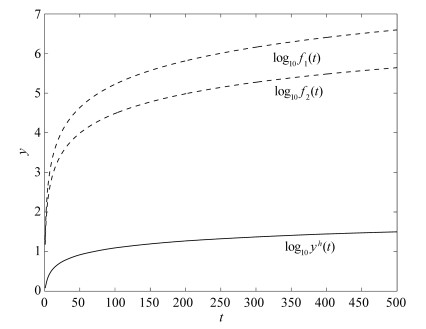1 引言
目前,仅有少量文献研究方程解的渐近估计.鉴于渐近估计不仅比渐近稳定性描述解的性态更加精确,而且能给出非稳定情形解的上界估计式. Iserles在文献[6]中构造了自治中立型比例延迟微分系统Dirichlet级数形式的解,获得了解析解的上界估计式及渐近稳定的充分条件. Liu等[8-9]考虑了非自治中立型比例延迟微分系统,获得了解析解的渐近估计. Čermák等[2]考虑了用梯形方法求解非自治非中立型变延迟微分方程,借助于一个泛函不等式获得了数值解的上界估计式及其渐近稳定的一个充分条件. Zhang等[13]考虑了用
2 离散格式
考虑一类变延迟中立型微分方程
其中
其中
其中,
且
综上所述,由方程(2.2)和(2.3)得到如下递推关系
其中
3 渐近估计
本节将构造方程(2.4)的解
并假设
及
在区间
其中
引理3.1[2] 设
定义
显然,
定理3.1 假设(3.2)式成立,
定义了方程(3.1)的一个正解,即
证 令
即对所有的
至此,我们显式给出了不等式(3.1)的一个解序列,进而能得到方程(2.4)解
定理3.2 设
特别地,当
证 首先,对方程(2.4)作变换
当
考虑任意的
(ⅰ)假设
对上式两边取绝对值且由不等式(3.1)估计
当
其中
(ⅱ)假设对任意的
其中
对上式两边取绝对值得
又因为
所以把上式代入(3.10)式且部分求和得
当
其中
其中
(ⅲ)假设
对方程(3.9)两边同乘
由
又由(3.1)式得
上式即为对不等式(3.10)右端作相应修改(用
其中
综上三种情况(ⅰ), (ⅱ), (ⅲ),对任意的
因此
故
注3.1 当
考虑不等式
并假设
及
则可以得到方程(3.11)解的渐近估计
特别地,当
注3.2 当
引理3.1与定理3.1的所有假设条件显然成立.此时,定理3.2与注3.1均是文献[13]中相关结论的直接推广,所以变延迟项
例3.1 考虑中立型延迟微分方程
其中
其中
不难验证,当
且解
推论3.1 设
推论3.2 设
4 数值算例
本节将用一个数值例子来验证已获理论结果的正确性及方法的有效性.
例4.1 考虑初值问题
取步长
即分别存在适当的实常数
因为
由定理3.2的证明可知,取
令
至此,我们给出了方程(3.16)的数值解
图 1分别给出了
图 1
参考文献
On the asymptotics of the trapezoidal rule for the pantograph equation
DOI:10.1090/S0025-5718-09-02245-5 [本文引用: 4]
Stability of one-leg methods for the variable coefficient pantograph equation on the quasi-geometric
A family of solutions of the IVP for the equation
An analysis of delay dependent stablity for ordinary and partial differential equations with fixed and distributed delays
On the generalized pantograph functional-differential equation
The functional-differential equation
Regular solutions of the Shabat equation
DOI:10.1006/jdeq.1998.3541 [本文引用: 1]
Discretized stablity and error growth of the non-autonomous pantograph equation
Stability analysis of θ-methods for nonlinear neutral functional differential equations
Nonlinear stability of Runge-Kutta methods for neutral delay differential equations
The asymptotic behaviour of the θ-methods with constant stepsize for the generalized pantograph equation
DOI:10.1080/00207160.2015.1061124 [本文引用: 3]



